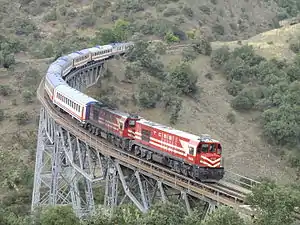TCDD DE24000
TCDD DE 24000 (stylised as DE 24 000 in painted registration numbers) is a type of diesel locomotive built for operations on Turkish State Railways (TCDD) by Tülomsaş. 218 units were built between 1970-84 under license from Matériel de Traction Electrique (MTE) of France. The DE 24000 formed the backbone of the dieselisation of the Turkish railways during the 1970s. It follows the hood unit road switcher design, like most Turkish mainline locomotives. DE 24 000 is the most commonly found locomotive class in Turkey (418 units produced, more than 150 in usable state).
| DE 24000 [1] [2] | |||||||||||||||||||||||||||||||||||||||||||||||||||||||||||
|---|---|---|---|---|---|---|---|---|---|---|---|---|---|---|---|---|---|---|---|---|---|---|---|---|---|---|---|---|---|---|---|---|---|---|---|---|---|---|---|---|---|---|---|---|---|---|---|---|---|---|---|---|---|---|---|---|---|---|---|
 Two DE24000 locomotives pulling a westbound regional train. | |||||||||||||||||||||||||||||||||||||||||||||||||||||||||||
| |||||||||||||||||||||||||||||||||||||||||||||||||||||||||||
| |||||||||||||||||||||||||||||||||||||||||||||||||||||||||||
| |||||||||||||||||||||||||||||||||||||||||||||||||||||||||||
| |||||||||||||||||||||||||||||||||||||||||||||||||||||||||||
In addition to MTE, diesel parts were supplied by Chantiers de l'Atlantique, electric parts from Jeumont-Schneider, and mechanical parts from Forges et Ateliers du Creusot.
History
During the 1970s the Turkish State Railways decided to replace their 800 steam locomotives with diesel. This quite-delayed task required the delivery of more than 400 diesel units. On February 15, 1968, TCDD and MTE signed an agreement for delivery of the DE 24000 along with the delivery of the smaller DE18000. To build up domestic competence on diesel engines, TCDD decided that the production would be done by Tülomsaş of Turkey. Only Tülomsaş-built units are still operational.
Blue trains (Mavi tren) and DE 24000
Blue trains are express passenger trains with 120 km/h (75 mph) timetable speed. They originally started replacing black trains (Turkish: kara tren), which are trains pulled by black steam locomotives with tenders. All cars of the blue trains had blue livery and were pulled by blue DE24000s. They are now pulled by TCDD DE33000s and have regular livery but still retain their long-distance national passenger rail network status.
Overspeeding provision
These locomotives had been used over their power and speed ratings until 2004. Delayed trains were "force-fit" into the timetable by overspeeding up to 10% over timetable speeds. This required both overspeeding the prime mover and modifying the traction motors' final drive ratios. This practice was banned after the Pamukova train derailment.

External links
- Tönük, Ergin. "E 40003".
- "Trains of Turkey - DE 24 000".
- Replaced by clones manufactured by TÜLOMSAŞ(TLM 16V185) as they go under maintenance.